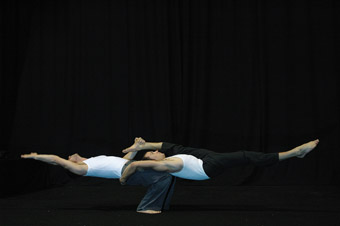 |
David Carberry, Darcy Grant, The Space Between photo John Donegan |
For most of us, trust in is one of the hardest things to achieve because of the inherent risk of putting our faith in others or, indeed, ourselves. Will we be let down, disappointed, left to fall? I suspect trust is a key theme in The Space Between but I’m not sure. Movement is not a language in which I’m particularly fluent but I trust the performers and creators to explore the themes fully.
There is no obvious narrative driving The Space Between. Instead we have three performers—two males, one female—working alone or in pairs with the occasional scene featuring all three. The links between scenes are more impressionistic than direct, building a layered exploration of the relationships between the performers. Like a poem, perhaps the key is in the title.
What is not in doubt is the sheer physical prowess of the performers. The show opens with a single performer falling backwards. He falls repeatedly before tumbling back onto his feet. It has a form of gracefulness but it is the sheer athletic skill, the physical energy and ability that strikes one. This visceral physicality is on display throughout the show. There are sequences where the performers tumble, roll and crawl across each other’s bodies. These are balanced with moments of stillness where the performers hold each other at dramatic angles. In a memorable sequence the female performer holds a small scarf while one of the men dives over and under it like a land-based dolphin. Amongst the solos, there is a wonderfully executed sight-gag involving a performer one of whose hands sticks to any surface it touches. The comic logic of the gag is followed through beautifully as his hand attaches to various parts of his body and the floor and he must contort his body accordingly. In the same scene the performer manages to get a collective wince out of the audience as he twists around on one wrist and seems to have dislocated his shoulder.
The playing space is simple—as it should be—a grey square with the audience on three sides. An occasional projection appears directly on the floor. These are always square and include letters or geometric shapes. The performers move through them but the effect only really lifts off when the square of light rotates and the male performers look like they're flying on a magic carpet. The music is an eclectic grab bag ranging from electronica through to Serge Gainsborough and Neil Young. Sometimes it works well, sometimes it’s a little too obvious and other times it’s just there.
The Space Between builds to a trapeze scene involving a repetition of the physical gestures we’ve seen played out on the floor but with the extra sense of risk engendered from being suspended. There are a couple of breathtaking moments when the female performer is about to fall only to have the male performer deftly capture her—or at least seem to. Towards the end of the same scene there is a moment where he appears to hold her using only his hand in her mouth. It’s a brief but striking image that seems extreme when compared with what has gone before. There are allusions to male threat, for example when the men grab hold of the woman and swing her back and forth like a skipping rope but there was no sense of overt menace. While we see the potential for physical danger, we fully trust that the male performers would not allow any harm.
Although the moments on the trapeze involved risk, I’m not sure that they evoked vulnerability, and that's what I thought was missing. I can’t escape the sense that the basic, physical language of circus—built on the polarity of risk and trust—makes it difficult to achieve more emotional nuance. While there were some tender moments—particularly between the two men—I can recall only one of overt aggression, again between the males. It is surprising in a piece about a love triangle that anger does not appear more frequently. Of course, as one male flew at the other in rage we could see the second male brace himself as he prepared his body to actually support his colleague. It was comforting to see.
Circa, The Space Between, created by Yaron Lifschitz and the Cira Ensemble, performed by David Carberry, Darcy Grant, Chelsea McGuffin, concept, direction, lights, sound design, multimedia and operation Yaron Lifschitz; Performance Works, Granville Island, Jan 22-26; PuSh International Festival of Performing Arts, Jan 16-Feb 3
Andrew Templeton is Vancouver-based writer and playwright who's had plays produced in Vancouver and London.
© Andrew Templeton; for permission to reproduce apply to [email protected]








 back
back